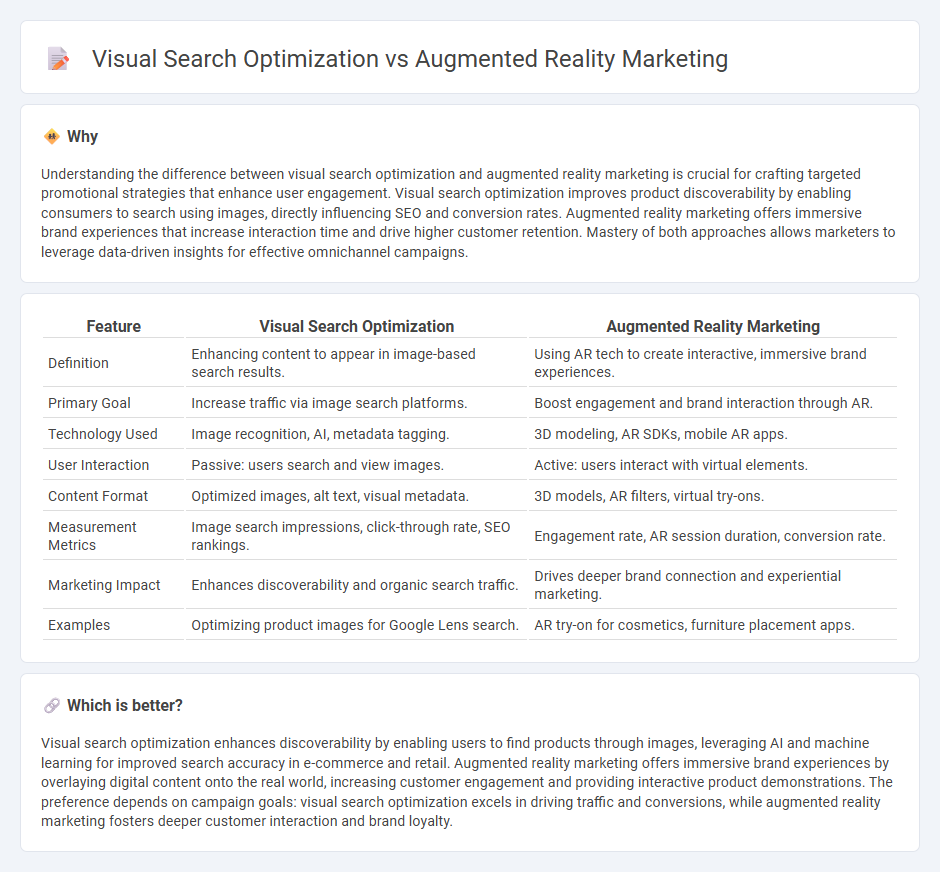
Visual search optimization enhances user experience by enabling consumers to find products through images, boosting e-commerce engagement and conversion rates. Augmented reality marketing immerses customers in interactive brand experiences, increasing product awareness and purchase intent through virtual try-ons and real-time demonstrations. Explore how these innovative technologies redefine marketing strategies and drive consumer interaction.
Why it is important
Understanding the difference between visual search optimization and augmented reality marketing is crucial for crafting targeted promotional strategies that enhance user engagement. Visual search optimization improves product discoverability by enabling consumers to search using images, directly influencing SEO and conversion rates. Augmented reality marketing offers immersive brand experiences that increase interaction time and drive higher customer retention. Mastery of both approaches allows marketers to leverage data-driven insights for effective omnichannel campaigns.
Comparison Table
| Feature | Visual Search Optimization | Augmented Reality Marketing |
|---|---|---|
| Definition | Enhancing content to appear in image-based search results. | Using AR tech to create interactive, immersive brand experiences. |
| Primary Goal | Increase traffic via image search platforms. | Boost engagement and brand interaction through AR. |
| Technology Used | Image recognition, AI, metadata tagging. | 3D modeling, AR SDKs, mobile AR apps. |
| User Interaction | Passive: users search and view images. | Active: users interact with virtual elements. |
| Content Format | Optimized images, alt text, visual metadata. | 3D models, AR filters, virtual try-ons. |
| Measurement Metrics | Image search impressions, click-through rate, SEO rankings. | Engagement rate, AR session duration, conversion rate. |
| Marketing Impact | Enhances discoverability and organic search traffic. | Drives deeper brand connection and experiential marketing. |
| Examples | Optimizing product images for Google Lens search. | AR try-on for cosmetics, furniture placement apps. |
Which is better?
Visual search optimization enhances discoverability by enabling users to find products through images, leveraging AI and machine learning for improved search accuracy in e-commerce and retail. Augmented reality marketing offers immersive brand experiences by overlaying digital content onto the real world, increasing customer engagement and providing interactive product demonstrations. The preference depends on campaign goals: visual search optimization excels in driving traffic and conversions, while augmented reality marketing fosters deeper customer interaction and brand loyalty.
Connection
Visual search optimization enhances consumers' ability to find products using images, aligning closely with augmented reality marketing, which overlays digital content onto the physical world. Integrating these technologies allows brands to deliver immersive shopping experiences that increase user engagement and conversion rates. Companies leveraging AI-driven visual search and AR tools gain competitive advantages by providing personalized, interactive marketing campaigns.
Key Terms
**Augmented Reality Marketing:**
Augmented Reality Marketing leverages immersive technology to blend digital content with the physical world, enhancing customer engagement and driving interactive brand experiences. This approach increases conversion rates by allowing consumers to visualize products in real-time environments, fostering deeper emotional connections and informed purchasing decisions. Explore how integrating AR into marketing strategies can revolutionize customer interaction and boost sales performance.
Immersive Experience
Augmented reality marketing enhances user engagement by integrating digital elements into real-world environments, creating immersive and interactive brand experiences that increase customer retention and conversion rates. Visual search optimization leverages AI-powered image recognition to enable users to search for products using photos, improving discovery and streamlining e-commerce interactions. Explore deeper insights into how these technologies revolutionize consumer interaction and drive sales.
Interactive Content
Interactive content in augmented reality marketing enhances user engagement by overlaying digital elements in real-world environments, driving immersive brand experiences and higher conversion rates. Visual search optimization enables consumers to find products effortlessly by leveraging image recognition technology, streamlining the purchasing journey through intuitive visual queries. Discover how integrating interactive content can elevate your marketing strategy and boost customer interaction.
Source and External Links
Augmented Reality Marketing: Benefits, Use Cases, Examples (2024) - Augmented reality marketing uses AR technology to enhance brand value and customer engagement by allowing consumers to interact with products digitally, improving conversion rates and delivering memorable experiences in online shopping environments.
Augmented Reality Marketing: A Systematic Literature Review and ... - AR marketing enriches consumer experiences by integrating digital information with real-world environments, boosting satisfaction, shaping behavior, and increasing company revenues through innovative presentation and interaction methods.
What is Augmented Reality (AR) Marketing? - Foundation Marketing - AR marketing blends digital and physical realms by overlaying interactive digital content onto the real world, offering immersive brand experiences such as personalized demos, 3D visualizations, and virtual trade shows that redefine how brands engage audiences.
 dowidth.com
dowidth.com